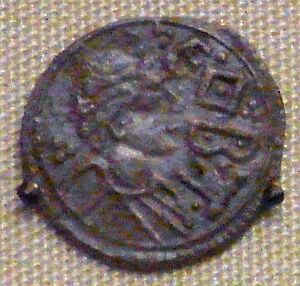Cynethryth facts for kids
Quick facts for kids Cynethryth |
|
|---|---|
| Queen consort of Mercia | |

Portrait penny of Cynethryth, minted by Eoba at Canterbury. Cynethryth is the only Anglo-Saxon queen known to have had coins issued in her name and these are unique in Western Europe of the period. Coin held by the British Museum.
|
|
| Died | after 798 |
| Spouse | Offa of Mercia |
| Issue | Ecgfrith, King of Mercia Eadburh, Queen of Wessex Ælfflæd, Queen of Northumbria Æthelburh Æthelswith |
Cynethryth (pronounced Kin-eth-rith) was a powerful Queen of Mercia in Anglo-Saxon England. She was the wife of King Offa of Mercia, one of the most important kings of his time. Cynethryth was also the mother of King Ecgfrith of Mercia. She is famous for being the only Anglo-Saxon queen whose name appeared on coins. This was very unusual for the period.
Contents
Biography
Early Life and Marriage
We don't know much for sure about where Cynethryth came from. Her name sounds similar to other queens and princesses from the Mercian royal family. This might mean she was related to King Penda of Mercia, an earlier Mercian ruler.
Unlike some royal marriages of the time, Cynethryth's marriage to Offa was approved by the church. This shows that she was respected. A famous scholar named Alcuin even wrote to her son, Ecgfrith. He told Ecgfrith to follow the good example of his parents, including his mother's strong faith. Alcuin also called Cynethryth the "controller of the Royal household." This suggests she had a very important role in the palace.
Queen of the Mercians
We don't know the exact date Offa and Cynethryth got married. However, Cynethryth started to sign important documents, called charters, after her son Ecgfrith was born. She first signed a charter in 770. By 780, she was officially known as Cyneðryð Dei gratia regina Merciorum. This means "Cynethryth, by the Grace of God, Queen of the Mercians." This title shows her high status.
Cynethryth is unique because coins were made with her name on them. This was very rare in Western Europe during that time. Some historians think this might have been inspired by Empress Irene of Athens in the Byzantine Empire. However, the pictures on Cynethryth's coins looked more like those of ancient Roman empresses. This was similar to how Offa's coins showed him looking like a Roman emperor. These coins are a special part of Anglo-Saxon history.
Cynethryth worked alongside her husband on many important matters. She was also known for supporting churches. For example, she was a patron of Chertsey Abbey. Even Pope Adrian I wrote to both Offa and Cynethryth together. This happened when he made the Bishopric of Lichfield into an Archbishopric.
Later Life and Religious Order
After King Offa died in 796, Cynethryth chose to join a religious order. She became the abbess of a monastery at Cookham. An abbess is the head of a community of nuns. She also took charge of the church at Bedford, where Offa was buried. Historians believe she might be buried at Cookham herself. Archaeologists from the University of Reading are currently studying this possibility.
Cynethryth was still alive in 798. At that time, she was involved in a disagreement over church lands. This dispute was with Æthelhard, the Archbishop of Canterbury. It was settled at a meeting called the Synod of Clofesho.
Family
King Offa had at least five children. It is believed that all of them were also Cynethryth's children. They were:
- Ecgfrith (died 796) - He became King of Mercia but ruled for only 141 days before he died.
- Eadburh - She became Queen of Wessex, as the wife of King Beorhtric of Wessex.
- Ælfflæd - She became Queen of Northumbria, married to King Æthelred I of Northumbria.
- Æthelburh - She became an abbess, leading a religious community.
- Æthelswith - She might be the same person as Ælfthryth of Crowland.
Recent Discoveries
In August 2021, archaeologists made an exciting discovery. A team led by Gabor Thomas from the University of Reading found a monastery site. It dates back to the time of Queen Cynethryth. This monastery was found in the grounds of Holy Trinity Church in Cookham, Berkshire.
The archaeologists found many interesting items. These included old food remains and pottery vessels. They also found a beautiful bronze bracelet and a dress pin. These discoveries will help us learn more about how the monks and nuns lived. They show us what they ate, how they dressed, and how they worked.




